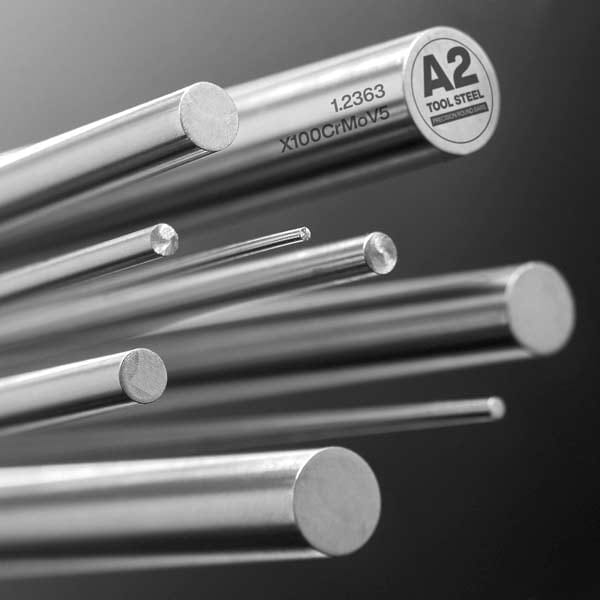Introduction: Why Machining A2 Tool Steel Demands Expertise
A2 tool steel is a widely used air-hardening tool steel known for its exceptional toughness, wear resistance, and dimensional stability during heat treatment. Its unique properties make it a popular choice among tool steel suppliers for industries requiring durable molds, dies, and cutting tools. However, machining this versatile material presents unique challenges due to its high hardness and abrasion resistance.
This article explores the best tools and techniques for machining A2 tool steel, providing insights into achieving precision and efficiency.
1. Selecting the Right Cutting Tools for A2 Tool Steel
Effective machining of A2 tool steel begins with choosing suitable cutting tools that can withstand its hardness.
- Carbide Tools: Tungsten carbide tools are highly recommended for machining A2 tool steel due to their superior wear resistance and heat tolerance.
- Coated Inserts: Titanium Nitride (TiN) or Aluminum Titanium Nitride (AlTiN) coated tools can enhance performance by reducing friction and extending tool life.
- High-Speed Steel (HSS): For less demanding operations, HSS tools may be used but with reduced cutting speeds to minimize tool wear.
Tool steel suppliers often emphasize the importance of high-quality tooling to achieve consistent results.
2. Optimizing Cutting Parameters for A2 Tool Steel
Machining A2 tool steel requires precise control over cutting parameters to balance productivity and tool life.
- Cutting Speed: Lower cutting speeds, typically between 100-150 surface feet per minute (SFM), are recommended to prevent tool overheating.
- Feed Rate: Moderate feed rates help achieve smoother finishes without excessive tool wear.
- Depth of Cut: Shallow cuts reduce the risk of tool damage and improve surface quality.
Adjusting these parameters based on the specific hardness of the A2 tool steel ensures optimal performance during machining.
3. Cooling and Lubrication: Essential for Machining Success
Cooling and lubrication play a critical role in machining A2 tool steel, helping to manage heat and improve tool life.
- Flood Coolant: Continuous application of coolant ensures proper heat dissipation during high-speed operations.
- Mist Lubrication: For finer machining, mist systems provide adequate lubrication without excessive coolant waste.
- Specialized Cutting Fluids: Use cutting fluids specifically designed for tool steel suppliers, as these formulations offer superior cooling and lubrication properties.
Effective cooling minimizes thermal expansion and ensures consistent machining tolerances.
4. Techniques for Achieving Precision in A2 Tool Steel
Precision is critical when machining A2 tool steel for high-performance applications. Employing advanced techniques ensures accurate results.
- Climb Milling: This technique reduces tool deflection and produces a better surface finish when working with tough materials.
- High-Speed Machining (HSM): HSM strategies combine high cutting speeds with low depth of cuts to maintain efficiency while reducing tool wear.
- CNC Machines: Utilizing CNC machinery ensures precision through computer-guided operations, ideal for complex geometries.
Many tool steel suppliers recommend combining these methods to achieve both efficiency and accuracy.
5. Challenges in Machining A2 Tool Steel and Solutions
While A2 tool steel offers excellent performance, machining it can pose several challenges.
- Tool Wear: The hardness of A2 tool steel accelerates tool wear. Solution: Regular tool changes and using carbide tools with high wear resistance.
- Heat Buildup: Excessive heat can degrade tool life and affect the steel’s microstructure. Solution: Apply consistent cooling and reduce cutting speeds.
- Surface Finish Issues: Achieving smooth finishes may be difficult. Solution: Use fine-grit abrasives during finishing and maintain sharp cutting tools.
Identifying these challenges and addressing them promptly ensures successful machining outcomes.
6. Finishing and Polishing A2 Tool Steel
After machining, finishing processes are essential for enhancing the performance and appearance of A2 tool steel.
- Grinding: Employ precision grinding to achieve tight tolerances and a mirror-like finish.
- Honing: For internal surfaces, honing removes minor imperfections and improves surface smoothness.
- Polishing: High-quality polishing is critical for molds and dies to ensure optimal functionality in end applications.
Consulting with tool steel suppliers for specialized abrasives and finishing tools can further enhance results.
7. The Role of Tool Steel Suppliers in Machining Success
Tool steel suppliers play an integral role in ensuring the successful machining of A2 tool steel.
- Material Certification: Reputable suppliers provide detailed certifications, ensuring the steel meets required specifications.
- Technical Support: Many suppliers offer machining guidelines and recommend suitable tools and cutting fluids.
- Customization Services: Custom pre-machined blanks or heat-treated materials reduce machining time and costs.
Building a strong partnership with trusted tool steel suppliers guarantees access to high-quality materials and expert advice.
Conclusion: Mastering A2 Tool Steel Machining
Machining A2 tool steel requires a deep understanding of its properties and the use of specialized tools and techniques. From selecting the right cutting tools to optimizing parameters and implementing advanced machining strategies, every step contributes to the success of the process. Collaborating with experienced tool steel suppliers ensures access to the best materials and support for tackling the challenges of machining this durable alloy.
By mastering the art of machining A2 tool steel, manufacturers can unlock its full potential, delivering high-precision components that perform reliably in demanding applications.
Keep an eye for more news & updates on Qiuzziz!
